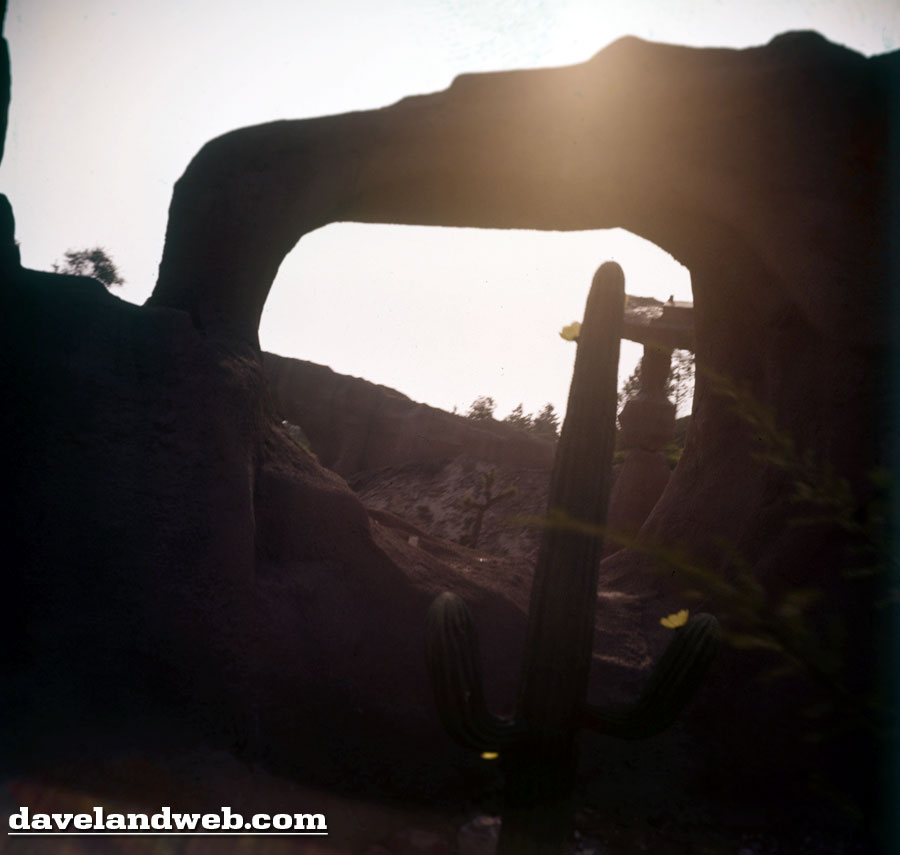
Winding down to the Big Finish with Part Six of Bob Weaver’s Nature's Wonderland attraction memories (only one more post to go!):
The Mine Train ran day and night, but I believe it was a much better show in the daytime. You could see more of it for one thing, and it had a more natural look. At night there were floodlights and spotlights, carefully hidden, but still you realized they were illuminating it. This gave kind of an artificial look to it, in my opinion. Sort of like when you turn the porch light on and catch a glimpse of a raccoon on the lawn. In daylight you saw every detail of the attraction and it was far more impressive and natural-looking. There was only one advantage to riding it at night. Some lucky riders were treated to a view of the nightly fireworks show, and some trains would stop at one point in the Living Desert to let them watch the fireworks. Other than that though, there really was no benefit to riding the Mine Train at night, unless you just wanted to relax and cool off for a while. Probably the best time to ride it was the last hour of daylight, when the setting sun highlighted the waterfalls illuminated the red sandstone rocks and buttes with a rich orange glow, while the sky above deepened to an azure shade and the park's nighttime personality started to awaken.
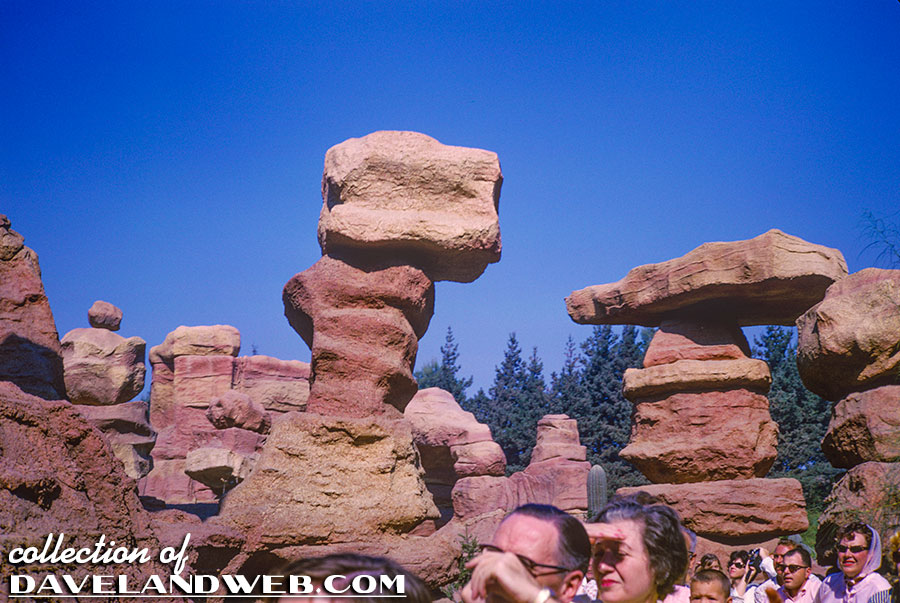
After the geysers, there was a small area of dinosaur bones which was kind of boring. But the next part made up for it. Balancing Rock Canyon was a group of piles of red sandstone "rocks" (which were probably hollow in the middle, but had a pretty convincing appearance of actual rock on the outside). The upper ones were constantly wobbling and I think a couple of the small ones at the tops of the stacks were actually spinning slowly. One of the rocks had another fake bobcat at the top looking down on you as you passed by. The train passed through this area and partially underneath some of the wobbling rocks. It was very scary for a small child, though in later years you realized it was all controlled and none of the rocks would actually fall. However in the park's later years, maintenance of attractions became notoriously lacking, resulting in death and injury. Perhaps they could have made the Mine Train a thrill ride just by letting everything go to pot, not bothering to check whether the balancing rocks were still stable, and marketing the attraction as "Nature's Wonderland: Deferred Maintenance Edition."
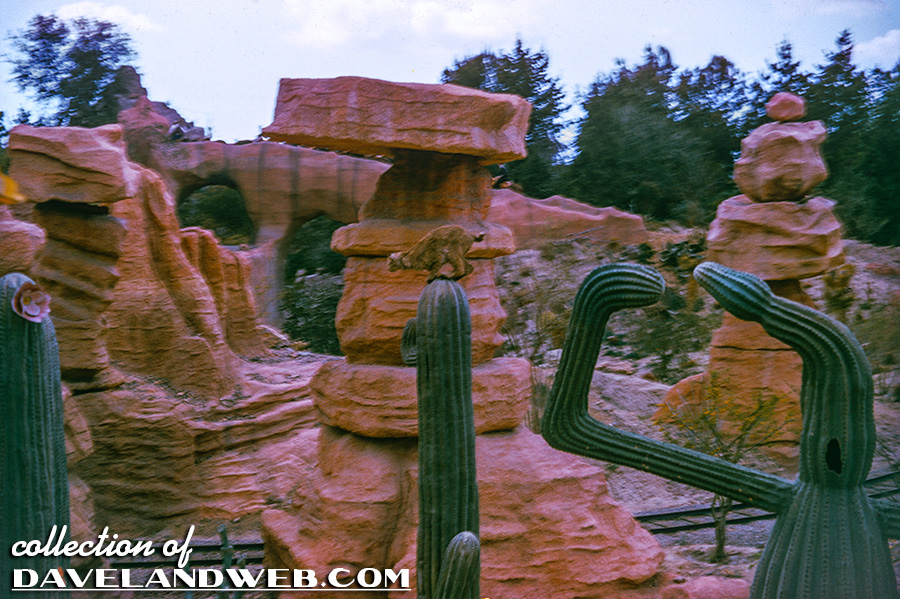
There was a small pond in the desert, apparently a watering hole as there were some kind of gazelle-type animals standing around it. To me the watering hole didn't look right in the desert, it surely would have dried up soon. Another peculiarity about the Mine Train was that there was no actual mine evident, or even any miners . It was just a trip through the natural world as Disney saw it.
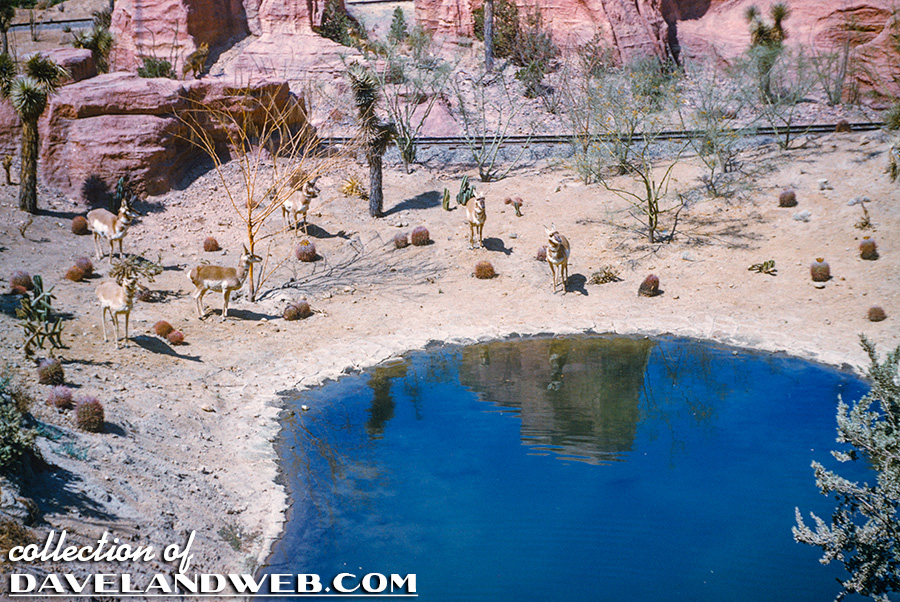
Near the end of the attraction it appeared as if the Mine Train was actually going to enter a mine. The train entered a hole in a hill, and it was pitch black inside. The narrator said, "Now, folks, we're goin' deep into the Earth to view the dazzlin' Rainbow Caverns." The train didn't actually go downhill, as far as I know the track was level. But the total darkness made it seem like you were going down into a hole. The first part of the caverns was pitch black with nothing to look at. This was to give your eyes a few seconds to adjust to the darkness before you would come upon the display inside. I think it was also to keep stray daylight from ruining the show inside. That was a wise decision, because what was inside was the most beautiful thing that Disneyland has ever had. No contest—Rainbow Caverns was the masterpiece of legendary Disney artist and Imagineer Claude Coats (January 17, 1913 - January 9, 1992). He worked for Disney for 54 years and was involved with the design of many of the best attractions in the park's history, and many of Disney's classic animated films including painting the backgrounds for many of the classic Disney animated films. Without question he is one of the greatest artists and designers in Disney history. His design and the park's implementation of Rainbow Caverns is what lifts the Mine Train Thru Nature's Wonderland out of the realm of the ordinary and into its truly legendary status. As soon as your eyes started adjusting to the darkness you would start seeing some of the features of Rainbow Caverns. This entire part of the attraction was pitch black and the only illumination came from fluorescent materials which lit up under the many black lights carefully hidden all over the place. I looked around a lot and I only saw blacklights; I never saw any colored lights or spotlights. Claude Coats may have been the world's first "blacklight artist" because he used the various fluorescent pigments in different ways and in different color combinations to create works of art. In Rainbow Caverns most of what you saw was liquid, in the form of fountains, waterfalls and little "rivers" on the floor. These had different colors, created by using large amounts of fluorescent pigments in the water. The plumbing system and maintenance must have been a giant headache because it was very complex, with many water effects each having their own colors. Different waterfalls and "rivers" right next to each other had different colors, and they could not mix with each other. There were small channels of color that even went on the floor underneath the train tracks, and you could peer straight down from the train to see these glowing channels of color liquid right below you. One channel would be green, the next orange, the next blue, the next yellow, and so on. There were some features such as stalactites and stalagmites which were painted in fluorescent colors, but most of what you saw was water in various colors. It was spellbindingly beautiful. Geyser Grotto had small greenish "geyser" type fountains in a greenish pond. Staircase Falls was one feature that was commonly photographed and appears on a famous postcard. However as I recall it was all blue, and though nicely designed and shaped was a little less interesting because it was all one color. There was one waterfall that consisted of six separate falls in six different colors, which really put the "Rainbow" in Rainbow Caverns. Where the colored fountains landed, they continued on the floor in individual channels of each color. The train traveled through the area (which was housed in a building) and it probably spent no more than one minute in the caverns. There were a couple of signs inside the caverns, also painted with flourescent paint and illuminated only by the blacklights. One sign pointed to Witch's Cauldron and that was yet another scare for the kids - although it turned out much to their relief that there was no witch on hand. Another sign on the same pole pointed to Geyser Grotto. There was a third sign but I can't remember what it said. A separate sign in another spot pointed in one direction and the sign said "To Bridal Veil Falls" but I never did figure out which one was Bridal Veil Falls. There are some photographs in existence, and easily found online, that illustrate Rainbow Caverns, but I have yet to see one which really captured it as it looked in person. About the best was probably the one taken by National Geographic magazine for their article on Disneyland. Color films at the time the attraction was in operation were not as sensitive to the relatively feeble light given off by fluorescent materials, and photographers would have to use an ultraviolet filter over the lens to block out the UV from the blacklights. I don't know of any color movies that exist showing Rainbow Caverns though I have seen a couple of black and white video clips, but watching them is akin to looking at one of those videos of an attraction "with the lights on" rather than how it looks in normal operation. The light used with the movie camera washes out any of the fluorescence of the waters. Too bad. The home video cameras of today would easily be able to capture the magnificent colors that were seen. In addition there was a dreamlike music soundtrack playing as you went through Rainbow Caverns, but the sound of rushing water made by the fountains and waterfalls was loud enough to almost drown it out. Too bad because the music was remarkable. It is also included on "A Musical History of Disneyland" that Disney released in 2005. It's mostly female voices singing a melody with just "ooooo wooooo" as the words, no lyrics. There is a harp and a piano playing in the background, plus another weird instrument that makes a warbling sound (I'm not sure what that instrument is called) altogether it's exotic and dreamy. But as I mentioned, the sounds of the fountains and waterfalls were loud and made even louder to the ears by all of this being indoors. Thus the music did not dominate but could be heard. This was the only section of the Mine Train that had music - the rest of the attraction had the narration and the sounds of nature alone, thankfully. It was cool and refreshing to be in Rainbow Caverns, even for the 45 seconds or whatever it was that the train was actually in it.
Once I had a blacklight of my own, I even attempted to build a small re-creation of this in my backyard, digging channels and lining them with foil, and pouring water mixed with colored fluorescent paint into each channel. Lasted all of one night, but it was fun and it gave me new respect for how difficult and complicated it had to have been for the Mr. Coats and the Disney Imagineers. One of the greatest blunders the park's management has ever made was the decision to destroy Rainbow Caverns, a major work of art by a major artist, just to make room for a second-rate thrill ride. What could they have been thinking as they watched the bulldozer? What could Mr. Coats have been thinking at that moment? When they were designing the Big Thunder Mountain Railroad ride, why couldn't they have simply incorporated the Rainbow Caverns into that ride? Or just kept Rainbow Caverns as as walk-through attraction. It was already built and right there. (And a 1959 aerial photo confirms that not only was the building covered with earth but also landscaped on top.) It's still hard for me to believe that someone in the park's management OK'd the demolition of this masterpiece. There are a couple of places in the park that serve as reminders of it, though.
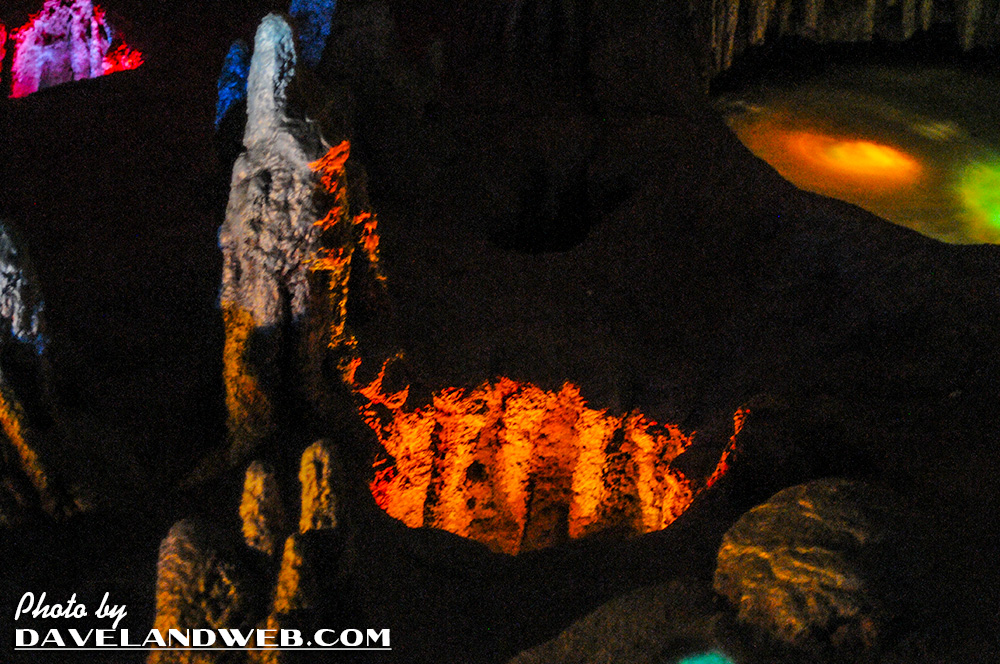
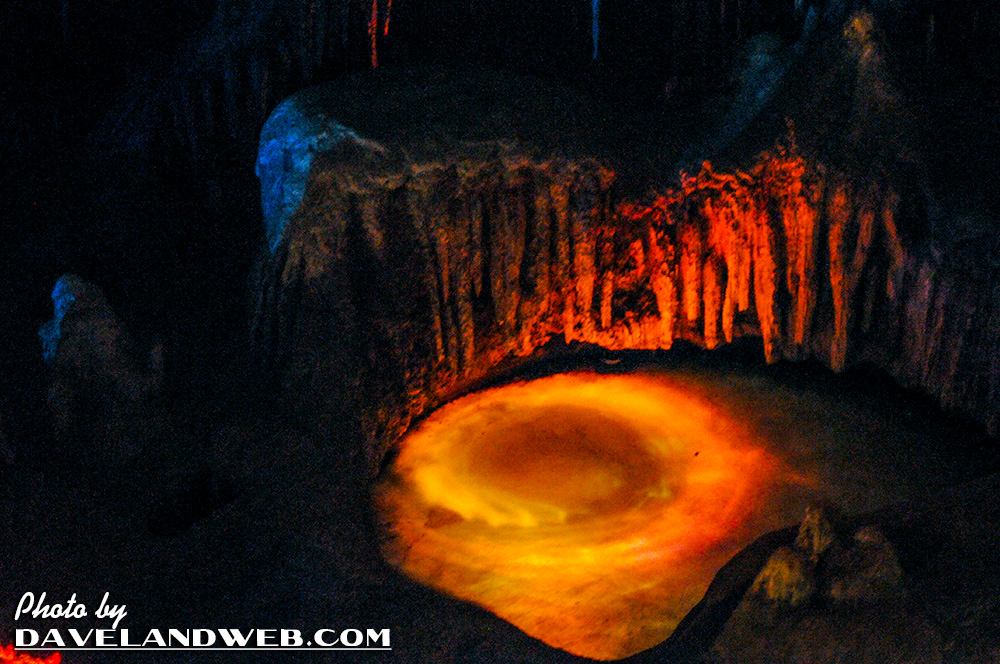
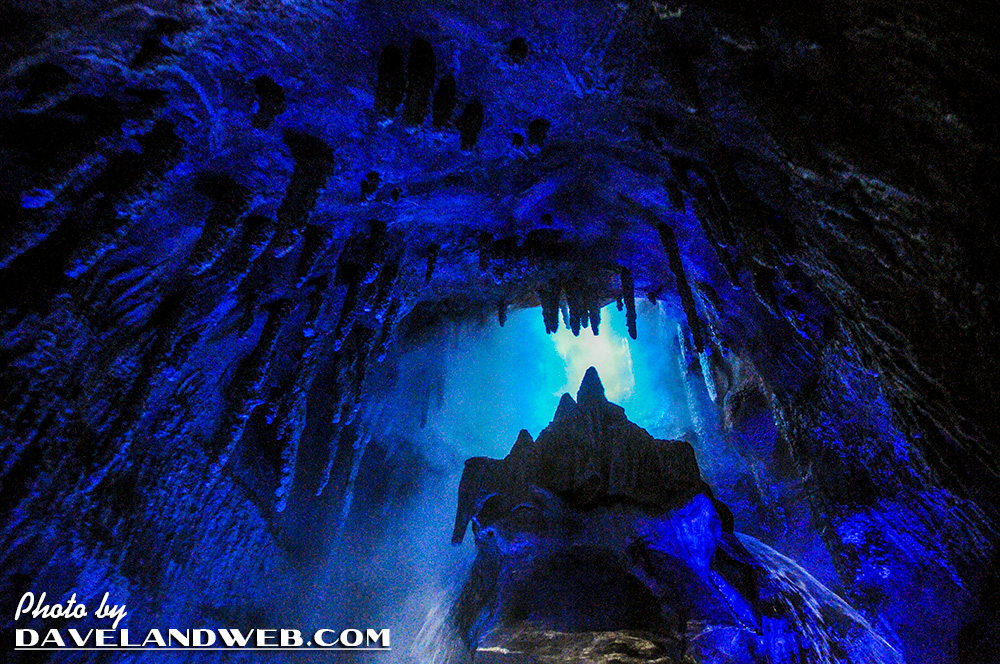
At the beginning of the Big Thunder Mountain Railroad ride, as the train is being lifted up the first hill, there is a display on the left with small caves and some water features, and some of it appears to be fluorescent. However I think some of it is lit by regular colored lights, and there is an awful lot of daylight leaking in from the entrance and exits the train goes through. So there's not nearly enough darkness to make it comparable to the original Rainbow Caverns, and it's a lot smaller too. In the Splash Mountain ride, there are some displays that include small jets of fluorescent green water, really just large drops of them that jump up and down, and when I first saw those I was reminded instantly of the fluorescent waters of Rainbow Caverns. The individual dancing droplets effect was something new though, I don't recall the water acting like that in Rainbow Caverns. In Knott's Berry Farm near Disneyland, there is a ride called the Calico Mine Train, and one scene inside it shows a cave which is painted in fluorescent paint and illuminated with black lights, but I think there are little or no water features there. Slowly the train left the incredible scene that was Rainbow Caverns and the last part was a dark tunnel that was not long. Again I think that was to keep out stray daylight from ruining the effect inside the caverns.
See more Disneyland Nature's Wonderland photos at my website.

5 comments:
I agree with Bob, it is a shame that there is no real visual record of the way that Rainbow Caverns looked (and yes, that National Geographic photo is the best).
And the Mine Train might have been better in the day, but I still wish I had experienced it at night. I like the Jungle Cruise at night, so I figure I'd like the Mine Train just as much.
Wonderful recollection....thank you, again! I agree with the comments about Big Thunder. Who needs it? The footprint for NWMT was bigger than Big Thunder. Cascade Peak was saved as well as some of the desert rockwork....they could have saved the Rainbow Caverns too. Gee, or how about saving the whole thing??? They could have just kept making additions and changes to it over the years. Hmmmm, I wonder what Walt would have done?
I remember that over the years the RC ride started to get a little shabby, and the numbers of riders were falling off. At the time, I assumed it was replaced because bean counters were following Knott's example of income generation.
I would always wait till the sun wen down in order to ride. It was far better at night, even though some of the details were missed. And the best was to be behind the falls as the Mark T. would go by all lit up. It was the best date-ride in the park.
Dave; I really appreciate your change in style of your blog. Combining your great collection of photos with actual blog commentary and histodry is terrific. Keep it up.
CoxPilot:
As a former operator of the attraction, I share your thoughts about the best time to ride the Mine Train. And your recollections are spot on. What was lost of the stark visuals of the day were more than offset by the softness and imagination prompting of the night. Plus the transition into the Caverns was seamless to the eye...the colors appeared more enhanced as a result.
I agree it was a crime to destroy Rainbow Caverns. I was fortunate enough to go on the ride about a dozen times in the 70s and it was one of my favorites.
Post a Comment